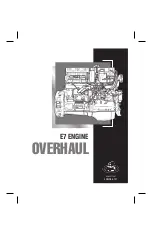
8
Installation and maintenance
LSRPM - PLSRPM
Synchronous permanent magnet motors
LEROY-SOMER
4155 en - 2012.05 / e
Balancing
Rotating machines are balanced in accordance with standard
ISO 8821:
- Half-key when the shaft extension is marked H
- No key when the shaft extension is marked N
- Full key when the shaft extension is marked F
Any coupling element (pulley, coupling sleeve, slip-ring, etc)
must therefore be balanced accordingly.
Motor with 2 shaft extensions:
If the second shaft extension is not used, in order to
comply with the balancing class, the key or half-key must
be fixed firmly in the keyway so that it is not thrown out
during rotation (H or F balancing) and must be protected
against direct contact.
Beware of backdriving when the motor is switched off. The
appropriate precautions must be taken:
- for pumps, a non-return valve must be installed.
- for mechanical devices, install a backstop or a holding brake.
- etc.
Tolerances and adjustments
The standard tolerances are applicable to the mechanical
characteristics given in our catalogues. They comply fully with
the requirements of IEC standard 72-1.
- Users must adhere strictly to the instructions provided by the
transmission device supplier.
- Avoid impacts which could damage the bearings.
Use a spanner and the tapped hole of the shaft extension with
a special lubricant (e.g. molykote grease) to make it easier to
fit the coupling.
The hub of the transmission device must be:
- fully in contact with the shoulder of the shaft or, if this is
missing, against the metal stop ring which forms a labyrinth
seal and thus locks the bearing in place (do not crush the seal).
- longer than the shaft extension (2 to 3 mm) so that it can be
tightened using a screw and washer. If it is not, a spacer ring
must be inserted without cutting the key (if this ring is large, it
must be balanced).
If there is a second shaft extension, it must only be used for
direct coupling and the same recommendations must be
followed.
Inertia flywheels
must not be mounted directly onto the shaft
extension, but installed between end shields and connected by
a coupling device.
Direct connection onto the machine
When mounted directly on the motor shaft extension of the
moving device (pump or fan turbine), check that this device is
perfectly balanced and that the radial force and the axial thrust
are within the limits indicated in the catalogue for bearing
performance.
Direct connection using a coupling sleeve
Selection of the coupling sleeve should take account of the
rated torque to be transmitted and the safety factor dependent
on the starting conditions for the electric motor.
The machines must be carefully aligned, so that any lack of
concentricity and parallelism in the two parts of the coupling
sleeve is compatible with the recommendations of the coupling
sleeve manufacturer.
The two parts of the coupling sleeve should be provisionally
assembled to make it easier to alter their relative position.
Adjust the parallel plane of both shafts using a gauge.
Measure the distance between the two coupling surfaces at
one point on the circumference. Rotate them 90°, 180° and
270° in relation to this initial position, and measure each time.
The difference between the two extreme values of dimension
«x» must not exceed 0.05 mm for standard couplings.
Applied
to shoulder of shaft
The 2nd shaft extension may also be smaller than
the main shaft extension, and under no circums-
tances can it deliver torques greater than half the rated
torque.
x
If a motor is started up without a coupling device
having been fitted, carefully immobilise the key in
its housing.
Applied
to stop ring









































